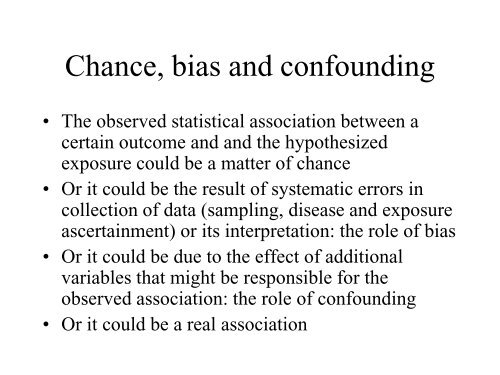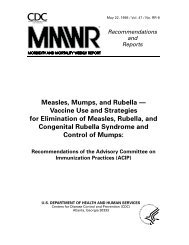Chance, bias and confounding - The INCLEN Trust
Chance, bias and confounding - The INCLEN Trust
Chance, bias and confounding - The INCLEN Trust
You also want an ePaper? Increase the reach of your titles
YUMPU automatically turns print PDFs into web optimized ePapers that Google loves.
<strong>Chance</strong>, <strong>bias</strong> <strong>and</strong> <strong>confounding</strong><br />
• <strong>The</strong> observed statistical association between a<br />
certain outcome <strong>and</strong> <strong>and</strong> the hypothesized<br />
exposure could be a matter of chance<br />
• Or it could be the result of systematic errors in<br />
collection of data (sampling, disease <strong>and</strong> exposure<br />
ascertainment) or its interpretation: the role of <strong>bias</strong><br />
• Or it could be due to the effect of additional<br />
variables that might be responsible for the<br />
observed association: the role of <strong>confounding</strong><br />
• Or it could be a real association
Confounder<br />
• Is a factor that distorts the true relationship<br />
between an exposure <strong>and</strong> the disease outcome on<br />
account of its being associated with both the<br />
exposure as well as the disease<br />
• This distortion (over/underestimation) of the true<br />
relation between exposure <strong>and</strong> disease can occur<br />
only if this factor is unequally distributed between<br />
the exposed <strong>and</strong> unexposed groups
Confounding<br />
• A confounder is a third factor that is associated<br />
with the exposure <strong>and</strong> independently affects the<br />
risk of developing the disease<br />
• It distorts the estimate of true relationship between<br />
the exposure <strong>and</strong> disease: it may result in<br />
association being observed when none in fact<br />
exists; or no association being observed when a<br />
true relationship does exist
Confounder<br />
• A potential confounder must be predictive<br />
of disease independently of its association<br />
with the exposure under study<br />
• This means that there must be an<br />
association between the confounder <strong>and</strong><br />
disease even amongst the group unexposed<br />
to the exposure under investigation
Confounder<br />
• This third factor should not be merely an<br />
intermediate step in the cause <strong>and</strong> effect<br />
relationship between the exposure <strong>and</strong> the<br />
disease outcome<br />
• <strong>The</strong> association between the confounder <strong>and</strong><br />
the disease need not be causal. It may a<br />
marker for for a risk factor other than the<br />
one under investigation in a study.
Confounding<br />
• Confounding can lead to the observation of<br />
apparent differences between the study<br />
groups when they do not truly exist, or<br />
conversely, the observation of of no<br />
difference when they do exist.
An example of <strong>confounding</strong><br />
• A number of observational epidemiological<br />
studies have shown an inverse association between<br />
the consumption of vegetables rich in β carotene<br />
with the risk of cancer<br />
• It is however possible that this association is<br />
confounded by other differences between the<br />
consumers <strong>and</strong> non-consumers of vegetables such<br />
as fiber, which is known to reduce the risk of<br />
cancer
Confounding: another example<br />
• An observed association between the consumption<br />
of coffee <strong>and</strong> the risk of MI could be due, at least<br />
in part, to the effect of cigarette smoking, since<br />
coffee drinking is associated with smoking , <strong>and</strong><br />
independent of coffee drinking, smoking is a risk<br />
factor for MI<br />
• <strong>The</strong> potential or true confounders are not always<br />
as obvious as they are in the examples cited above
How to avoid <strong>confounding</strong><br />
• If a <strong>confounding</strong> factor does not vary between the<br />
exposed <strong>and</strong> non-exposed, or those diseases <strong>and</strong><br />
non-diseased, then by definition, there can be no<br />
<strong>confounding</strong> by that variable<br />
• Thus if by design or analysis, the association<br />
between disease <strong>and</strong> exposure is evaluated only<br />
amongst those who are similar with respect to the<br />
<strong>confounding</strong> factor, there can be no <strong>confounding</strong>
Controlling confounders<br />
• Restriction of the study population<br />
• Matching<br />
• R<strong>and</strong>omization of exposure<br />
• Stratification<br />
• Multivariable analysis
Common confounders<br />
• Age <strong>and</strong> sex are almost universal<br />
confounders for all exposure – disease<br />
associations<br />
• This is because they are markers for a<br />
whole lot of cumulative exposures. <strong>The</strong>y<br />
may not be causally related to disease, but<br />
are markers for many other exposures<br />
which might be truly related to disease.
Confounding: the intermediate<br />
link<br />
• Moderate consumption of alcohol is associated<br />
with reduced risk of CAD<br />
• HDL cholesterol also is protective for CAD<br />
• Moderate alcohol consumption increases HDL<br />
• If one controls for HDL, the association between<br />
alcohol intake <strong>and</strong> the risk of CAD becomes weak<br />
or statistically insignificant.<br />
• Being an intermediate link between alcohol <strong>and</strong><br />
the risk of CAD, should HDL be considered a<br />
confounder at all Should it be controlled
Positive <strong>and</strong> negative<br />
<strong>confounding</strong><br />
• Tobacco smoking would be a positive<br />
confounder in association between coffee<br />
drinking <strong>and</strong> CAD<br />
• <strong>The</strong> association between physical activity<br />
<strong>and</strong> CAD would be negatively confounded<br />
by gender, since women have lower risk of<br />
CAD <strong>and</strong> they also exercise less than men.
R<strong>and</strong>omization<br />
• Applicable only to interventional studies<br />
• Most powerful method to control for<br />
known, potential or unknown confounders<br />
if the sample size is sufficiently large
Restriction<br />
• Reduces the number of eligible subjects for<br />
enrollment<br />
• It limits generalizability of observations to<br />
only the restricted population use for<br />
drawing the r<strong>and</strong>om sample
Matching<br />
• It includes elements of both design <strong>and</strong> analysis<br />
• Mostly applicable to case-control study design<br />
• It is expensive, difficult <strong>and</strong> time consuming<br />
• By design, the effect of risk factor which has been<br />
matched can not be studied<br />
• Confounding is avoided not just by matching but<br />
by special method of matched table analysis
Analysis<br />
• Stratified analyses: Stratum specific estimates of<br />
association are calculated, <strong>and</strong> the differences<br />
amongst the strata are assessed by eyeballing, or<br />
performing appropriate tests of statistical<br />
significance<br />
• Summary statistic for the pooled data is calculated<br />
as per the method of Mantel <strong>and</strong> Haenszel<br />
• <strong>The</strong> magnitude of <strong>confounding</strong> is assessed by<br />
looking at the discrepancy between the crude <strong>and</strong><br />
adjusted estimates (without applying any tests of<br />
statistical significance)
Confounding <strong>and</strong> effect<br />
modification<br />
• Confounding distorts the true relationship between<br />
the exposure <strong>and</strong> disease <strong>and</strong> should be controlled<br />
• Effect modification tells us that the association<br />
between exposure <strong>and</strong> disease is modified by a<br />
third factor. It should not be controlled for, the<br />
magnitude of effect modification should be<br />
reported <strong>and</strong> biological explanation for its<br />
presence sought.
Bias<br />
• <strong>The</strong> study must be designed <strong>and</strong> conducted in such<br />
a manner that that every possibility of introducing<br />
a <strong>bias</strong> is anticipated <strong>and</strong> steps are taken to<br />
minimize its occurrence<br />
• In spite of these precautions, the observed<br />
association should be carefully examined to see if<br />
it could be explained by <strong>bias</strong>.<br />
• If indeed the study has elements of <strong>bias</strong>, it can not<br />
be rectified at the stage of analysis (unlike<br />
<strong>confounding</strong>)
Types of <strong>bias</strong><br />
• Selection <strong>bias</strong>: A particular problem in case<br />
control <strong>and</strong> retrospective cohort studies<br />
where both exposure <strong>and</strong> disease have<br />
occurred at the time of selection of<br />
individuals for the study<br />
• Information <strong>bias</strong>
Selection <strong>bias</strong><br />
• Differential surveillance, diagnosis or<br />
referral of individuals in the study: e.g.,<br />
women using estrogen have uterine<br />
bleeding more often, <strong>and</strong> seek medical<br />
attention for this symptom. Hence they are<br />
more likely to seek diagnostic evaluation<br />
than those who are not on estrogens<br />
resulting in more frequent diagnosis of<br />
uterine cancer in women on estrogens
Multivariate regression analysis<br />
• Several potential confounders can be<br />
controlled; this is not easy in stratified<br />
analysis<br />
• It is an efficient method of data analysis<br />
• Several models for regression exist. Choice<br />
depends on the type of data to be analysed.

















